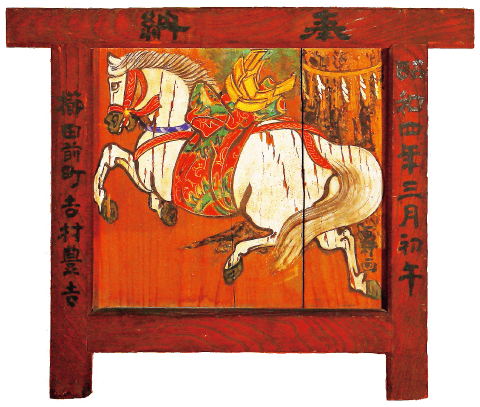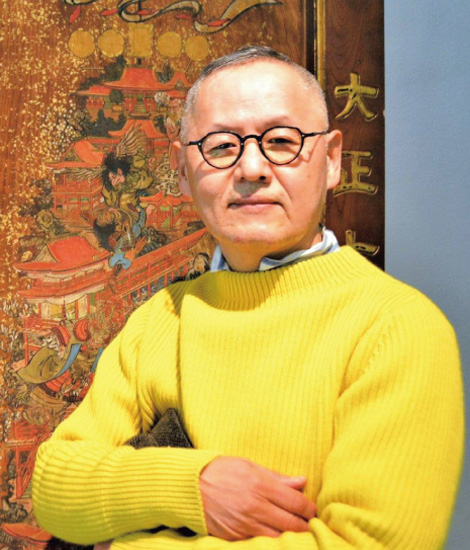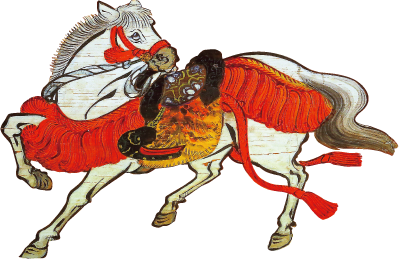百耕とは?
about Hyakko
そもそも絵馬そのものが、今では受験合格を祈って小絵馬を神社に奉納するくらいの認識しかないでしょう。でも少なくとも昭和30年代くらいまでの日本では、地域の人たちがお金を出し合って厄除け、安全・健康・長寿などの共通の願いを叶えてもらうために大絵馬を神社に奉納する習慣が日常にあったのです。
そしてその願いを託された絵を描く絵師の事を「絵馬師」と言い、江戸時代から戦前までは日本中の都市部では少なからずいたのです。でも戦後の昭和30年代にはほとんどいなくなり、福岡市の博多にいた実質上最後の絵馬師が吉村百耕でした。
百耕は本名を豊吉(とよきち)と言い、明治11年(1878)11月26日に福岡県福岡市櫛田前町22番地(現在の福岡市博多区冷泉町6番21号)に、地主であった父吉三郎と母トヨの長男として生まれました。吉村家は代々博多人形師の家でしたが、百耕は幼い頃より絵画が何よりも好きでしたので、少年時代に筑前福岡藩の南画家の上田鉄耕に師事し、「耕」の一字を雅号にいただいたのです。
百耕絵馬の特長は、カラフルでエネルギッシュでダイナミックなこと、粋で洒脱なこと、細部の表現にまでぬかりのないことでしょう。

博多最後の絵馬師 吉村百耕
1878(明治11)〜 1958(昭和33)
1878(明治11)〜 1958(昭和33)
Hyakko Yoshimura(1878~1958)
The Last EMA Painter in Hakata.
The Last EMA Painter in Hakata.
In Japan up to the mid-1960s, there used to be a custom that people in communities raised money to donate large ema for common prayer or wishing for a safe trip to Ise Jingu, or a safe return from war, good health, longevity, good luck and so on. And there were many professional ema painters in large towns in the Edo era. However, after the Pacific War (the Second World War), the number decreased drastically.
Hyakko Yoshimura was one of the few ema painters who lived in Hakata, Fukuoka City. His real name was Toyokichi and he was born on November 26th in 1878 and passed away on May 2nd in 1958 at the age of 79. His family’s profession was Hakata doll maker for generations.
He studied Japanese painting under Tekko Ueda, a famous local Nanga artist. He started painting ema professionally at the age of 17 and continued painting until the age of 78. For 61 years, he painted hundreds of ema with various subjects. According to the research done by the Fukuoka provincial government, approximately 180 of his works still exist in shrines throughout the province of Fukuoka. Therefore, he can be called “The last EMA painter in Hakata.” Unfortunately, he is now almost forgotten among the populace of Fukuoka.
絵馬とは?
古代よりわが国では、馬は神の乗り物として神聖視されていて、そのため祭事や雨乞い・日乞いのため生き馬の献上がしばしば行われていました。
しかし馬自体が貴重で高価な動物であった事と、餌代と世話をする人の賃金など主として財政的な理由から、藁や土や木製の馬型になり、やがて板に馬の絵を描いた絵馬になりました。それが絵馬の原型ですが、室町時代から題材はさらに合戦図、大漁豊作、健康・安全・長寿祈願や歌舞伎などへと発展していったのです。

The origin of Ema
In ancient times the Japanese regarded horses as the “vehicles of the gods,” so they offered living horses to the gods who they thought would listen to their prayers and fulfill their wishes, for example: to get rain or to stop it when it has been raining cats and dogs for a while, but as well for health, longevity, good fortune, and so on. But since horses were very valuable and expensive as it cost a lot of money to keep a horse, they used a substitute made of straw, clay or wood.
Later a wooden board with a painted horse turned up. That was the origin of ema. Further, the size of ema became larger and themes of ema developed into various ones like, historic battle scenes, popular samurai, rich harvest, kabuki plays, etc.
百耕の孫 吉村精高
福岡市博多区冷泉町生まれ。大学受験英語塾「福岡英語塾」主催。
福岡市立旧冷泉小学校、旧博多第二中学(現博多中学)、西南学院高校卒業。明治大学法学部中退。
中学ではESC、高校・大学では演劇部に所属、映画監督を志すも根性と才能のなさで挫折。大学中退後に様々な職業を経験するが、20代後半に特技の英語を生かして外資系会社に貿易責任者として就職。30代半ばで独立しファッションの輸入販売に携わるが、40代の終わりに英語を教える天分に目覚め転身、現在に至る。
2015カンヌ映画祭応募作「デラシネ」を製作・監督。
合気道三段:合気道祥平塾・高砂道場所属

百耕の孫 吉村精高
1952年(昭和27)5月7日生まれ
1952年(昭和27)5月7日生まれ
Kiyotaka, Keith, Yoshimura
Born on May 7, 1952, in Hakata, Fukuoka City, Japan.
Educational background: graduated from Seinan Gakuin High School, dropped out of Meiji University
I belonged to a drama club in high school and university to be a film director. But I gave up my dream as I had little talent. After leaving my university, as I was fluent in English, I got a job as a foreign trade manager in an American company in my late twenties. While working for the company, I traveled to India, which drastically changed my philosophy. Then I started my own business importing clothes. Finally, in my late forties, I settled in Fukuoka where I have been teaching English for almost thirty years.
In 2015, I produced and directed “Déraciné,” a movie which was applied to Canne International Film Festival.


